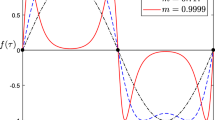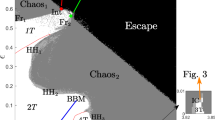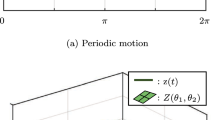Abstract
A generalized mathematical model of an inverted double pendulum with asymmetric follower force is developed. The model accounts for all possible types of springs: hard, soft, and linear. The influence of equitype springs on the equilibrium states is examined
Similar content being viewed by others
REFERENCES
J. M. T. Thompson, Instabilities and Catastrophes in Science and Engineering, Wiley, New York (1982).
I. G. Boruk and L. G. Lobas, “Evolution of limit cycles in the stability domain of a double pendulum under a variable follower force,” Int. Appl. Mech., 40, No.3, 337–344 (2004).
V. A. Dzhupanov and Sv. V. Lilkova-Markova, “Dynamic stability of fluid-conveying cantilevered pipe on an additional combined support,” Int. Appl. Mech., 39, No.2, 185–191 (2003).
L. G. Lobas and L. L. Lobas, “Bifurcations and catastrophes of the equilibrium states of an overturned double pendulum subjected to an asymmetric follower force,” Stabil. Contr. Theor. Appl., 4, No.2, 110–118 (2002).
L. G. Lobas, L. D. Patricio, and I. G. Boruk, “Equilibrium of an inverted mathematical double-link pendulum with a follower force,” Int. Appl. Mech., 38, No.3, 372–376 (2002).
L. L. Lobas, “Influence of an asymmetric follower force on the stationary states of a double-link pendulum,” Int. Appl. Mech., 37, No.12, 1618–1623 (2001).
A. Pfluger, Stabilitatsprobleme der Elastostatik, Springer, Gottingen-Heidelberg-Berlin (1950).
Y. Shirohara, “A geometric method for the numerical solution of non-linear equations and its application to non-linear oscillations,” Publ. Res. Inst. Math. Sci., Kyoto Univ., 8, No.1, 13–42 (1972).
V. A. Storozhenko, “A technique for identification of the principal central axis of inertia in an inhomogeneous rigid body,” Int. Appl. Mech., 39, No.12, 1464–1472 (2003).
H. Troger and A. Steindl, Nonlinear Stability and Bifurcation Theory, Springer-Verlag, Wien-New York (1991).
H. Ziegler, “Die Stabilitatskriterien der Elastomechanik,” Ing. Arch., 20, No.1, 49–56 (1952).
Author information
Authors and Affiliations
Additional information
__________
Translated from Prikladnaya Mekhanika, Vol. 41, No. 2, pp. 103–109, February 2005.
Rights and permissions
About this article
Cite this article
Lobas, V.L. Influence of the Nonlinear Characteristics of Elastic Elements on the Bifurcations of Equilibrium States of a Double Pendulum with Follower Force. Int Appl Mech 41, 197–202 (2005). https://doi.org/10.1007/s10778-005-0077-5
Received:
Issue Date:
DOI: https://doi.org/10.1007/s10778-005-0077-5




